Poodle
This article needs additional citations for verification. (May 2021) |
| Poodle | |||||||||||||
|---|---|---|---|---|---|---|---|---|---|---|---|---|---|
 | |||||||||||||
| Other names | |||||||||||||
| Origin | Germany or France (see history) | ||||||||||||
| |||||||||||||
| |||||||||||||
| Dog (domestic dog) | |||||||||||||
The Poodle, called the Pudel in German and the Caniche in French, is a breed of water dog. The breed is divided into four varieties based on size, the Standard Poodle, Medium Poodle, Miniature Poodle and Toy Poodle, although the Medium Poodle variety is not universally recognised.
The Poodle is most commonly claimed to have been developed in Germany, although it is also claimed to be from France, the Standard Poodle was originally used by wildfowl hunters to retrieve game from water. The smaller varieties of the breed were bred from the original in France where they were once commonly used as circus performers, but have become popular companion dogs.
History

A majority of cynologists believe the Poodle originated in Germany, the dog they refer to is roughly equivalent to the modern Standard Poodle sized variety, it is claimed it was known in Germany from the Middle Ages and it was Germany’s water dog, just as England had the English Water Spaniel, France the Barbet, Ireland the Irish Water Spaniel and the Nethlands the Wetterhoun.[1][2][3][4][5] Among the evidence used to support this theory is the indisputably Germanic name for the breed, Poodle or "Pudel" in German, which is derived from the Low German word "puddeln" which means "to splash", additionally there exists a number of artistic works by various German artists from as early as the 17th century that depict dogs of recognisably Poodle type.[1][2][3][5] Some cynologists believe the Poodle originated in France, where it is known as the "Caniche" (French for "duck dog"), and that the breed descends from the Barbet, this view is shared by the Fédération Cynologique Internationale.[6][7] Others still variously contend the breed originated in Russia, Piedmont or Northwest Africa.[4][7]
Whatever the Poodle's country of origin, as both their German and French breed names indicate the modern Poodle's ancestors were widely used by waterfowlers both to retrieve shot game as well as to recover lost arrows and bolts that had missed their mark.[3][4] The breed's distinctive lion coat clip developed as a practicality when they used as waterfowler's dogs, the long hair around the chest provided insulation for the dog's vitals in freezing water, the shorn hindquarters reduced drag whilst swimming and the tufts of hair on the legs provided purchase in the water.[3][5]
Due to their intelligence, biddable natures, athleticism and looks the Poodle was frequently employed in circuses, particularly in France.[2][3][5][7] It was in French circuses that the breed was selectively bred down in size to create what is now known as the Miniature Poodle, which was until 1907 known as the Toy Poodle, as a smaller sized dog is easier to handle and transport in a travelling circus.[5] As circus performers the variety was frequently seen performing all manner of tricks including walking tightropes, acting out comedies and even performing magic and card tricks, outside of the circus the variety was to become an extremely popular companion dog.[2][3][5]

The Toy Poodle was created at the beginning of the 20th century when breeders again bred the Miniature Poodle down in size to create a popular companion dog.[2][3][5] Initially these efforts were not entirely effective and disfigured or misshapen pups as well as behavioural problems were frequently seen, a result of irresponsible breeding for dwarfed size only, but as time progressed and considered breeding practices were adopted the variety became set as a toy sized replica of the original.[2][3][5] Later attempts to create an even smaller variety, the Teacup Poodle, were unable to overcome serious genetic abnormalities and were abandoned.[5]
The last of the Poodle varieties to be recognised was the Medium Poodle, which in size is mid way in between the Standard and the Miniature Poodle, not universally recognised by the world's kennel clubs as a variety, it is recognised by the Fédération Cynologique Internationale and most Continental European kennel clubs.[3][5][6] One of the reasons for creating this fourth size variety is believed to be a desire to reduce the number of entries of Poodles by variety at conformation shows.[5]
Description
Appearance
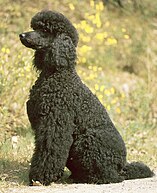
The Poodle is an active, athletic breed with the different breed varieties varying predominantly by their size.[1][2][3] The Fédération Cynologique Internationale's breed standard states the Standard Poodle stands between 45 and 62 centimetres (18 and 24 in), the Medium Poodle between 35 and 45 centimetres (14 and 18 in), the Miniature Poodle between 28 and 35 centimetres (11 and 14 in) and the Toy Poodle 24 and 28 centimetres (9.4 and 11.0 in); some kennel clubs do not recognise the Medium Poodle variety, they typically state the Standard Poodle stands between 38 and 60 centimetres (15 and 24 in) and Miniature Poodle between 28 and 38 centimetres (11 and 15 in), with the toy variety remaining unchanged.[3][5][6] A healthy adult Standard Poodle typically weighs between 20 and 32 kilograms (44 and 71 lb), a Medium Poodle between 15 and 19 kilograms (33 and 42 lb), a Miniature Poodle between 12 and 14 kilograms (26 and 31 lb) and a Toy Poodle between 6.5 and 7.5 kilograms (14 and 17 lb).[3]
Coat
The Poodle does shed, but instead of the fur coming off the dog, it becomes tangled in the surrounding hair. This can lead to matting without proper care. Texture ranges from coarse and woolly to soft and wavy. Poodle show clips require many hours of brushing and care per week, about 10 hours/week for a Standard Poodle. Poodles are usually clipped down into lower-maintenance cuts as soon as their show careers are over. Pet clips are much less elaborate than show and require much less maintenance. A pet owner can anticipate grooming a Poodle every six to eight weeks. Attention must be paid to a poodle's ears, because hair grows in their ears. They should be cleaned religiously with a solution and hair should be removed, so that earwax buildup does not accumulate and moisture does not take hold, both causing infection. Some claim that poodles are hypoallergenic.[8]
Clips and grooming

Over 50 different styles of coat clips are recognised for the Poodle; the most popular in the show ring is the Continental clip where the face and rear end of the body are clipped, leaving tufts on the hocks and tip of the tail and rosettes on the hips.[5]
Corded coat
In most cases, whether a Poodle is in a pet or show clip, the hair is completely brushed out. Poodle hair can also be "corded" with rope-like mats similar to those of a Komondor or human dreadlocks. Though once as common as the curly Poodle, corded Poodles are now rare. Corded coats are difficult to keep clean and take a long time to dry after washing. Any Poodle with a normal coat can be corded when its adult coat is in. Corded Poodles may be shown in all major kennel club shows.[6][9][10]
Colours
The Poodle has a wide variety of colouring, including white, black, brown, blue, gray, silver, café au lait, silver beige, cream, apricot, and red, and patterns such as parti-, abstract, sable, phantom, and brindle. The AKC recognizes Poodles in either solid-coloured and multi-colored coats; however, only solid-colored poodles may compete in conformation.[9] Recognition of multi-colored Poodles varies by registry. Recognized FCI colourations are black, white, brown, gray, apricot, and red.
For solid-coloured Poodles, the coat is an even and solid colour at the skin. In blues, grays, silvers, browns, café au laits, apricots, and creams, the coat may show varying shades of the same color. This is frequently present in the somewhat darker feathering of the ears and in the tipping of the ruff. While clear colors are preferred by registries, such natural variation in the shading of the coat is not to be considered a fault. Brown and café au lait Poodles have liver-coloured noses, eye rims and lips, dark toenails and dark amber eyes. Black, blue, gray, silver, cream, and white poodles have black noses, eye rims and lips, black or self-coloured toenails and very dark eyes. In the apricots, while the foregoing colouring is preferred, liver-coloured noses, eye rims and lips, and amber eyes are permitted, but are not desirable. Incomplete colour of nose, lips and eye rims, or a "mismatched" colour are considered faults by registries.
Parti-coloured Poodles are recognized in Poodle history as the original colouring of the Poodle. A parti-Poodle has solid-coloured patches over a white coat. The coat will usually be white and coloured in equal amounts, though it can vary with a larger percent of white. Registries prefer that parti-Poodles have the same points as its correlating solid-coloured descendants. Brown and white parti-Poodles have liver-coloured noses, eye rims and lips, dark or self-coloured toenails and amber eyes. This is also permitted, but not preferred, in apricot and white parti-Poodles. Black/white, blue/white, and silver/white parti-Poodles have black noses, eye rims and lips, black or self-coloured toenails and very dark eyes. When the dog has markings that resemble those of a tuxedo, it is called a "tuxedo" Poodle. The upper coat is solid black: head, back, tail; and the lower coat is white: neck, chest, abdomen, and legs, making up usually 40% or more of the coat.
Phantom Poodles have the colouring of a Doberman Pinscher, with a lighter colour appearing on their "eyebrows", muzzle and throat, legs and feet and below their tail. Like Dobermans, phantom Poodles have either a black or brown main coat with tan (usually apricot or red) lighter colourings around the eyebrows, muzzle, throat, legs, feet, and below their tail.
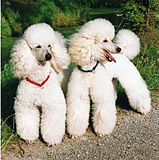
White Poodles
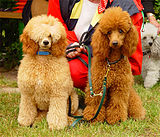
Apricot and red Poodles
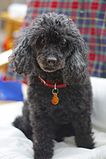
Black Poodle
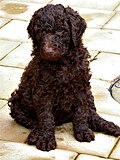
Brown Standard Poodle at five weeks

Mature silver Poodle

Phantom Poodles
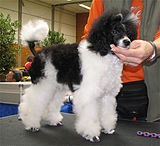
Miniature parti-Poodle
Temperament
Poodles are known as a highly intelligent, energetic, and sociable breed. They require both physical and intellectual activities. A typical Poodle should be reserved and a little aloof with strangers upon first introduction, but after a while should slowly reveal a warm and personable disposition once the dog realizes the new person is trustworthy and means no harm. Snappy, vicious behavior is considered a serious fault in the breed. Though not suitable for being a guard dog because it is neither a territorial breed nor particularly aggressive, Poodles who are well loved and cared for will reciprocate with devotion and loyalty: a dog of this breed is normally quiet and calm, but if it is totally sure danger is near, it quickly becomes very protective of its master, its master's spouse, and its master's children.
Poodles are highly trainable dogs that typically excel in obedience training. A Poodle will do well at many dog sports, including dog agility, flyball, dock diving, dog surfing, field tracking, disc dog,[11] and, for the larger-sized Poodles, even schutzhund. They will enjoy hiking and camping trips with their masters or families. Their background as duck dogs means centuries of instinctive attraction to water and thus they can go on any trip involving swimming, whether in the sea, at the lake, or even in whitewater up to class III for the Standard, though a lifejacket is paramount for all of the above. However, all individual dogs, even from breeds who are talented swimmers like the Chesapeake Bay Retriever or the Portuguese Water Dog, require a gentle introduction to water before they are comfortable in it and will not start swimming readily as young puppies. Poodles are no different and must learn that water is a place to play first.
Of the size varieties, Standard Poodles are the most highly recommended for families with children. Because of the haircuts popular in the show ring and their history of being dogs of the middle and upper classes for so long, the Standard Poodle has been stereotyped as an effete and frou-frou dog. Presuming that stereotype is true where children and teenagers are concerned is a grave mistake, because the truth is that a Standard Poodle will rejoice at the opportunity to bounce around, even roughhouse in the dirt. They have a merry, kindly demeanor and they adore playing games that spark their interest in physical and social stimulation. For example, with school age children and teenagers they will be absolutely delighted at the prospect of playing hide and seek. The Standard would be very happy playing baseball or tennis with kids and teenagers, because that means catching wayward balls in their mouths. They would be happy to run alongside a teenager on a skateboard in autumn, to slide down the hill on a sled in winter with younger children, or to jump in the swimming pool in summertime to chase after diving rings or to splash with the kids so long as they have been taught how to use the stairs to get out and water safety skills for dogs.
As with all dogs, introductions to babies should be gradual, though most Standards will tolerate a baby and learn to be gentle and will respect toddlers so long as the child is supervised. A Standard Poodle will be fine in a family with many children provided the environment is stable, orderly, and relaxed, with enough room for the dog to go out and retire somewhere quiet if needed.[12] The Miniature and Toy varieties tend to have less patience with young children and might find certain children's antics too much to handle, especially because young children are much larger than they are and may attempt to grab them without understanding how this is frightening to a small dog. They are likely to bite out of fear and thus are better suited to homes with teenagers or older children. Poodles dislike being left alone or left out of the family fun and some get anxious at being left in the house alone, but signs of nervousness or neurosis are atypical and not how a Poodle of any size is meant to behave. Miniature and Toy Poodles must not be treated like babies; they must not be picked up and carried around constantly and without being put on a leash to walk: they will start to believe they are in charge and that they do not owe anyone good behavior, and thus they become very spoiled and uncontrollable.
Work and sport

Since the late 1980s, some breeders in the United States and Canada have been selecting for dogs with drive for birds in order to revive the breed for hunting, with some success.[13]
Poodles have been used as working dogs in the military since at least the 17th century, most likely because of their highly intelligent, trainable nature and background as a gundog making them suitable to battlefields, as evidenced by their ability to be trained to ignore gunfire. During the English Civil War, Prince Rupert of the Rhine had a hunting Poodle he brought over with him from what is today Germany with a white coat who liked to ride into battle with his master on horseback. Bonaparte wrote in his memoirs about the faithfulness of a grenadier's pet Poodle who stayed with the body of his master at the Battle of Marengo, licking his face and willing him alive again.[14]
Hypoallergenic qualities
Poodles are often cited as a hypoallergenic dog breed. Their individual hair follicles have an active growth period that is longer than that of many other breeds of dogs; combined with the tightly curled coat, which slows the loss of dander and dead hair by trapping it in the curls, an individual Poodle may release less dander and hair into the environment. In addition, most Poodles are frequently brushed and bathed to keep them looking their best; this not only removes hair and dander, but also controls the other potent allergen, saliva.
Although hair, dander, and saliva can be minimized, they are still present and can stick to "clothes and the carpets and furnishings in your home"; inhaling them, or being licked by the dog, can trigger a reaction in a sensitive person. An air cleaner, air duct outlet and vacuuming with a vacuum cleaner with a HEPA filter can help clear dander floating in the air.
See also
- Dogs portal
- List of dog breeds
References
- ^ Jump up to: a b c Alderton, David (1987). The dog: the most complete, illustrated, practical guide to dogs and their world. London: New Burlington Books. pp. 87–88. ISBN 978-0-948872-13-6.
- ^ Jump up to: a b c d e f g Alderton, David (2008). The encyclopedia of dogs. Bath: Parragon Books Ltd. pp. 131 & 354. ISBN 978-1-4454-0853-8.
- ^ Jump up to: a b c d e f g h i j k l Fogle, Bruce (2009). The encyclopedia of the dog. New York: DK Publishing. pp. 68–69, 190 & 282. ISBN 978-0-7566-6004-8.
- ^ Jump up to: a b c Hancock, David (2013). Gundogs: their past, their performance and their prospects. Ramsbury, Marlborough: The Crowood Press Ltd. pp. 33 & 37–38. ISBN 978-1-84797-492-1.
- ^ Jump up to: a b c d e f g h i j k l m Morris, Desmond (2001). Dogs: the ultimate dictionary of over 1,000 dog breeds. North Pomfret, VT: Trafalgar Square Publishing. pp. 295–297 & 526–529. ISBN 978-1-57076-219-2.
- ^ Jump up to: a b c d "FCI-Standard N° 172: Poodle" (PDF). Fédération Cynologique Internationale. 23 January 2015. Retrieved 21 March 2021.
- ^ Jump up to: a b c Fiorone, Fiorenzo (1973). The encyclopedia of dogs: the canine breeds. New York: Thomas Y. Cromwell Company. pp. 377–381. ISBN 978-0-690-00056-6.
- ^ Grady, Denise (5 February 1997). "Nonallergenic Dog? Not Really". The New York Times. Archived from the original on 30 January 2009. Retrieved 21 April 2011. How hypoallergenic the dog is may vary with the individual dog and the individual person.
- ^ Jump up to: a b "Poodle". American Kennel Club. Retrieved 7 February 2021.
- ^ "United Kennel Club: Standard Poodle Breed Standard. Retrieved May 12, 2007". Archived from the original on 11 November 2006.
- ^ Sentinel, Anne Geggis, Sun. "Boca Raton celebrity poodle London goes for world title". Sun-Sentinel.com. Retrieved 4 March 2019.
- ^ "Poodle (Standard) : Dog Breed Selector : Animal Planet". Animal Planet. Archived from the original on 18 February 2015. Retrieved 11 December 2014.
- ^ "Poodles ready to hunt". Denverpost.com. 19 February 2008. Archived from the original on 11 December 2014. Retrieved 11 December 2014.
- ^ Cawthorne, Nigel (2012). Canine Commandos: The Heroism, Devotion, and Sacrifice of Dogs in War. Ulysses Press. ISBN 978-1-61243-055-3.
External links
| Wikimedia Commons has media related to Poodle. |
- Toy dogs
- FCI breeds
- Dog breeds originating in France
- Dog breeds originating in Germany
- Gundogs
- Water dogs






